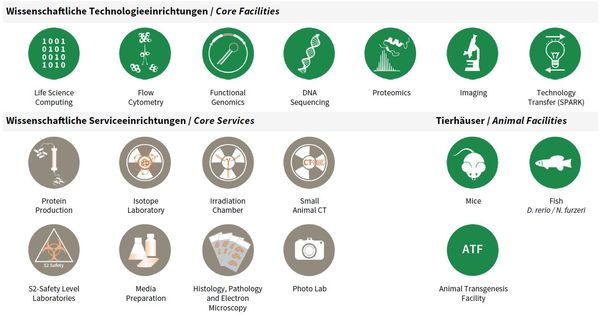Core Facilites and Core Services
At the beginning of 2016, a “core” structure was put into effect that organized facility and service units as independent organizational entities from FLI’s research groups. A number of technology platforms (e.g. sequencing, mass spectrometry) grew out of individual methodological requirements for single research groups in the last years but developed into semiautonomous substructures. As consequence of re-focused research activities and the concomitant advent of new research groups at FLI, those units increasingly had to serve many FLI groups and collaborative research efforts in the Jena research area.
To accommodate this development and to increase efficiency as well as transparency for users, facility personnel and for administrative processes, it came natural to re-organize such activities into independent units as “FLI Core Facilities and Services” and to phase out infrastructures considered non-essential for FLI’s research focus (X-ray crystallography and NMR spectroscopy).
FLI’s Core Facilities (CF) are managed by a CF Manager and are each scientifically guided in their activities and development by an FLI Group Leader, as Scientific Supervisor. The animal facilities comprising fish, mouse and transgenesis are run separately, as they involve a more complex organizational structure. Basic Core Services (CS) are directly led by the Head of Core (HC), who in turn is supported by individual CS Managers.
All facilities and services, including animal facilities, have a valuable contribution to FLI’s research articles; e.g. from 2016–2018, to 54% of all peer reviewed research publications.
Overview Core Facilities and Core Services at FLI.
Publications
(since 2016)
2022
- Sendungsregister
Mohnheim F, Weinzierl I, Hoppe B, Bösger J
2022, URL https://github.com/mohnbroet - Aging Activates the Immune System and Alters the Regenerative Capacity in the Zebrafish Heart.
Reuter H, Perner B, Wahl F, Rohde L, Koch P, Groth M, Buder K, Englert C
Cells 2022, 11(3), 345. doi: 10.3390/cells11030345 - Rhodopsins build up the birefringent bodies of the dinoflagellate Oxyrrhis marina.
Rhiel E, Hoischen C, Westermann M
Protoplasma 2022, 259(4), 1047-60 - Ezrin deficiency triggers glial fibrillary acidic protein upregulation and a distinct reactive astrocyte phenotype.
Schacke S, Kirkpatrick J, Stocksdale A, Bauer R, Hagel C, Riecken LB, Morrison H
Glia 2022, 70(12), 2309-29 - Pollutants corrupt resilience pathways of aging in the nematode C. elegans.
Scharf A, Limke A, Guehrs KH, von Mikecz A
iScience 2022, 25(9), 105027 - Restoring Age-Related Cognitive Decline through Environmental Enrichment: A Transcriptomic Approach.
Schmidt S, Haase M, Best L, Groth M, Lindner J, Witte OW, Kaleta C, Frahm C
Cells 2022, 11(23), 3864 - PLCG1 is required for AML1-ETO leukemia stem cell self-renewal.
Schnoeder TM, Schwarzer A, Jayavelu AK, Hsu CJ, Kirkpatrick J, Döhner K, Perner F, Eifert T, Huber N, Arreba-Tutusaus P, Dolnik A, Assi SA, Nafria M, Jiang L, Dai YT, Chen Z, Chen SJ, Kellaway SG, Ptasinska A, Ng ES, Stanley EG, Elefanty AG, Buschbeck M, Bierhoff H, Brodt S, Matziolis G, Fischer KD, Hochhaus A, Chen CW, Heidenreich O, Mann M, Lane SW, Bullinger L, Ori A, Eyss Bv, Bonifer C, Heidel F
Blood 2022, 139(7), 1080-97 - The EMT transcription factor ZEB1 governs a fitness-promoting but vulnerable DNA replication stress response.
Schuhwerk H, Kleemann J, Gupta P, van Roey R, Armstark I, Kreileder M, Feldker N, Ramesh V, Hajjaj Y, Fuchs K, Mahapatro M, Hribersek M, Volante M, Groenewoud A, Engel FB, Ceppi P, Eckstein M, Hartmann A, Müller F, Kroll T, Stemmler MP, Brabletz S, Brabletz T
Cell Rep 2022, 41(11), 111819 - Locus-specific expression analysis of transposable elements.
Schwarz R, Koch P, Wilbrandt* J, Hoffmann* S
Brief Bioinform 2022, 23(1), bbab417 * equal contribution - Age-dependent effects of Igf2bp2 on gene regulation, function, and aging of hematopoietic stem cells in mice.
Suo M, Rommelfanger MK, Chen Y, Amro EM, Han B, Chen Z, Szafranski K, Chakkarappan SR, Boehm BO, MacLean AL, Rudolph KL
Blood 2022, 139(17), 2653-65









